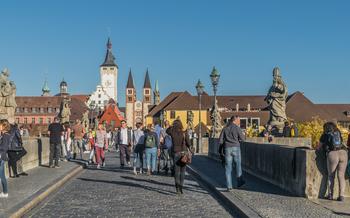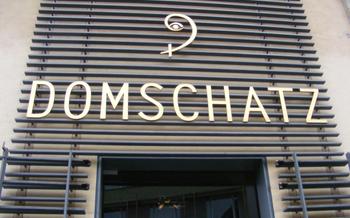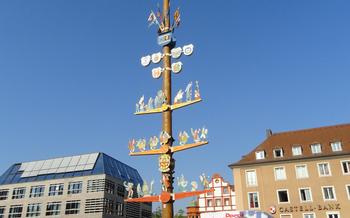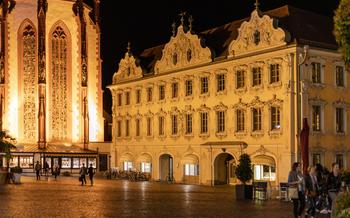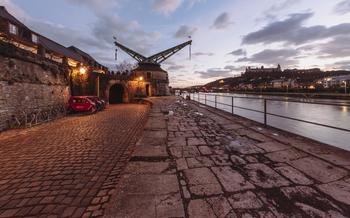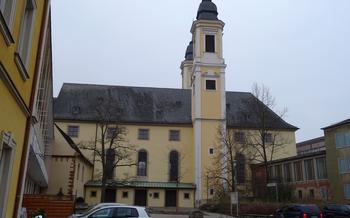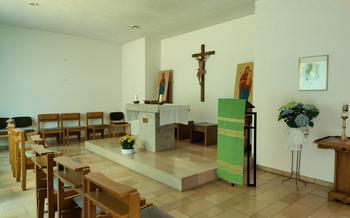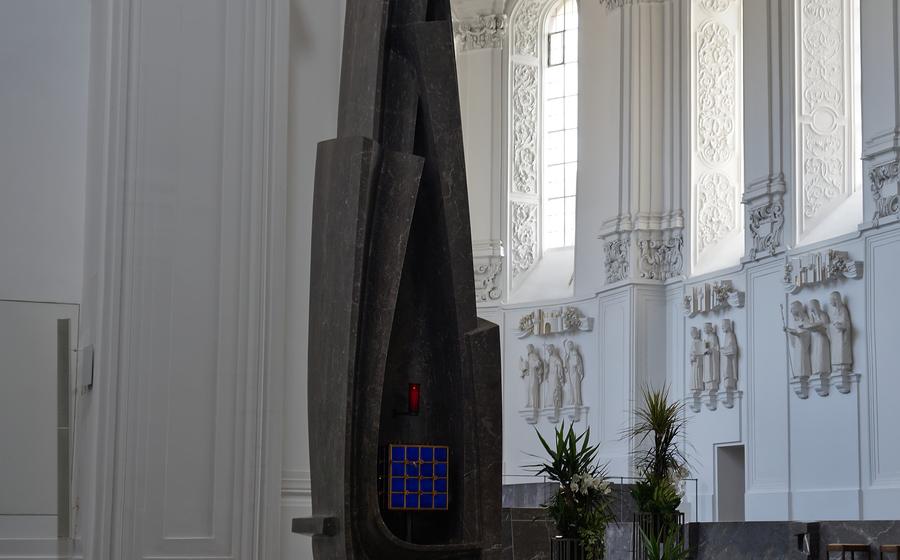
St. Kilian Cathedral
- Historical Significance
- Architectural Marvel
- Interior Highlights
- St. Kilian's Tomb
- Würzburg Residenz: A Royal Neighbor
- Marienberg Fortress: A Majestic Guardian
- Würzburg Hofgarten: A Baroque Masterpiece
- Würzburg Cathedral Music
- Würzburg Cathedral Guided Tours
- Accessibility
- Pilgrimage Route
- Local Festivals and Events
- Würzburg Christmas Market
- Insider Tips:
Historical Significance
The St. Kilian Cathedral, a majestic testament to history, stands as the spiritual heart of Würzburg. Its roots trace back to the 8th century, when Bishop Burkhard consecrated the original church on this site. Over time, the cathedral underwent numerous expansions and renovations, embodying the city's rich heritage. In the 11th century, Bishop Bruno of Würzburg initiated the construction of the Romanesque basilica, which formed the foundation of the present structure. The cathedral's significance as a pilgrimage site grew with the arrival of the relics of St. Kilian, the patron saint of Würzburg, in the 8th century. Pilgrims from across Europe flocked to the cathedral to seek spiritual guidance and healing. Despite surviving numerous wars and fires, the cathedral's enduring spirit remains, earning it the prestigious title of a UNESCO World Heritage Site, a testament to its exceptional cultural and historical value.
Architectural Marvel
The Würzburg Cathedral is a splendid example of Romanesque-Gothic architectural style, showcasing a harmonious blend of Romanesque and Gothic elements. Its four towers, each with its distinct design, are a remarkable sight to behold. The north tower, known as the Neumünster Tower, stands tall with its octagonal shape and intricate carvings. The south tower, called the Marienturm, boasts a graceful spire and elegant tracery. The west towers, referred to as the Kiliansdomtürme, are adorned with ornate pinnacles and delicate sculptures.
The cathedral's intricately carved stone portal, known as the "Fürstenportal," is a masterpiece of Romanesque art. The portal features a series of sculptures depicting scenes from the Bible, including the Annunciation, the Nativity, and the Adoration of the Magi. The sculptures are exquisitely detailed, showcasing the skill and artistry of the medieval craftsmen.
The interior of the cathedral is equally impressive, with its soaring vaulted ceilings and beautiful stained glass windows. The windows, created by various artists, depict biblical scenes and the lives of saints. The vibrant colors and intricate designs of the windows cast a warm and ethereal glow throughout the cathedral, creating a sense of awe and inspiration.
Interior Highlights
The interior of the Würzburg Cathedral is a testament to the grandeur and artistry of the Romanesque-Gothic architectural style. As you step inside, you are greeted by soaring vaulted ceilings that create a sense of awe and wonder. The vast expanse of the nave is adorned with intricate carvings and sculptures, each telling a unique story.
One of the most striking features of the interior is the high altar, which is a masterpiece of craftsmanship. Intricately carved and adorned with gold leaf, the altar is a fitting centerpiece for this magnificent cathedral. The pulpit is another highlight, featuring exquisite reliefs depicting scenes from the life of St. Kilian, the patron saint of Würzburg.
The cathedral also boasts numerous chapels, each with its own unique character and history. These chapels are adorned with beautiful stained glass windows, frescoes, and sculptures, creating a serene and contemplative atmosphere. One of the most popular chapels is the Marienkapelle, which is dedicated to the Virgin Mary and features a beautiful statue of the Madonna and Child.
St. Kilian's Tomb
St. Kilian, the patron saint of Würzburg, is deeply revered within the walls of the St. Kilian Cathedral. His tomb, situated in a prominent position within the cathedral, serves as a significant pilgrimage site, attracting countless visitors seeking spiritual guidance and healing. Legends and miracles surround the tomb, adding to its sacred aura.
One of the most compelling legends associated with St. Kilian's tomb involves a blind man who regained his sight after touching it. This miraculous event, among others, has solidified the belief in the saint's intercessory powers. Pilgrims often visit the tomb to pray for healing, comfort, and protection.
Every year, a special pilgrimage takes place in honor of St. Kilian, drawing thousands of faithful from near and far. During this pilgrimage, the saint's relics are carried in a solemn procession through the streets of Würzburg, creating a deeply moving and spiritual atmosphere.
St. Kilian's tomb stands as a testament to the enduring legacy of this beloved saint. Its presence within the cathedral invites visitors to reflect on the power of faith, the enduring strength of the human spirit, and the profound impact of sacred spaces on our lives.
Würzburg Residenz: A Royal Neighbor
In close proximity to the St. Kilian Cathedral stands another architectural masterpiece, the Würzburg Residenz. This UNESCO World Heritage Site was once the opulent palace of the prince-bishops of Würzburg, who ruled over the city for centuries. Its grand Baroque facade and elaborate interior reflect the wealth and power of the prince-bishops. Visitors can explore its staterooms, adorned with intricate frescoes, crystal chandeliers, and precious tapestries. The Residenz also houses an impressive collection of art and artifacts, including paintings by renowned masters such as Tiepolo and Canaletto.
The Würzburg Residenz shares a rich history with the St. Kilian Cathedral. Both landmarks were commissioned by the prince-bishops and constructed during the same period. They represent the culmination of Würzburg's architectural and artistic achievements. To fully appreciate the city's heritage, it is highly recommended to visit both the cathedral and the Residenz. This will provide a comprehensive historical experience and a deeper understanding of Würzburg's significance as a cultural and religious center.
Marienberg Fortress: A Majestic Guardian
Overlooking the city and the cathedral, the Marienberg Fortress stands as a testament to Würzburg's rich history. Originally a residence for the prince-bishops of Würzburg, this imposing structure has witnessed centuries of power and intrigue. Today, it serves as a museum, showcasing the grandeur of its past and offering visitors a glimpse into the lives of its former occupants.
Explore the fortress's many chambers and halls, each adorned with intricate carvings, opulent furnishings, and historical artifacts. Learn about the fortress's role in the Thirty Years' War and its transformation into a prison during the 19th century. Admire the stunning views of the city from the fortress's ramparts, where you can capture breathtaking panoramic shots of Würzburg's cityscape, with the cathedral standing tall amidst the tapestry of red-roofed houses.
For a truly immersive experience, take a guided tour of the fortress. Knowledgeable guides will regale you with tales of the fortress's past, bringing its history to life. Don't miss the opportunity to ascend to the fortress's observation tower, where you'll be rewarded with unparalleled views of the surrounding countryside.
Whether you're a history buff, an architecture enthusiast, or simply seeking a unique perspective of Würzburg, the Marienberg Fortress is a must-visit destination. Immerse yourself in its stories and soak in the breathtaking panoramas, creating lasting memories of your time in this captivating city.
Würzburg Hofgarten: A Baroque Masterpiece
Adjacent to the majestic Würzburg Cathedral lies the serene Würzburg Hofgarten, a Baroque-style garden that invites visitors to immerse themselves in its tranquil beauty.
Dating back to the 18th century, the Hofgarten was meticulously designed by Johann Lukas von Hildebrandt, the architect behind the Würzburg Residenz. Its geometric patterns, intricate pathways, and meticulously manicured lawns showcase the elegance and symmetry characteristic of the Baroque style.
As you stroll through the garden, you'll encounter an array of sculptures, fountains, and ornate gazebos, each adding to its charm and grandeur. Take a moment to admire the graceful statues of Greek gods and goddesses, or find respite from the sun under the shade of a towering tree.
The Hofgarten offers a tranquil oasis amidst the bustling city, inviting you to relax and soak in its serene atmosphere. Whether you're seeking a peaceful retreat or a place to admire the beauty of Baroque design, the Würzburg Hofgarten is a must-visit destination.
Würzburg Cathedral Music
The Würzburg Cathedral has a rich tradition of music that dates back centuries. The cathedral choir, one of the oldest in Germany, plays a vital role in liturgical services, performing a diverse repertoire of sacred music. The cathedral's organ, a magnificent instrument with over 9,000 pipes, is renowned for its exceptional acoustics, making it a popular venue for concerts and organ recitals.
Attending a concert or mass at the Würzburg Cathedral is a truly immersive experience. The cathedral's soaring vaulted ceilings and intricate stained glass windows create a breathtaking backdrop for the music, enhancing the emotional impact of each performance. Whether you are a classical music enthusiast or simply appreciate the beauty of sacred music, a visit to the Würzburg Cathedral is sure to be a memorable one.
Würzburg Cathedral Guided Tours
Discover the captivating history and intricate details of the Würzburg Cathedral through guided tours. Embark on a journey of enlightenment as experienced guides lead you through the cathedral's majestic interiors, revealing hidden stories and significant anecdotes. Regular tours provide a comprehensive overview of the cathedral's history, architecture, and religious significance. For those seeking a deeper dive, specialized tours delve into specific aspects, such as the cathedral's treasury, music, or pilgrimage route.
Enhance your visit by booking a guided tour in advance, especially during the peak tourist season, to secure your spot and avoid disappointment. Let the knowledgeable guides captivate you with intriguing tales and insights, transforming your visit into a truly memorable experience.
Accessibility
The Würzburg Cathedral is committed to providing an inclusive and welcoming environment for all visitors, regardless of their abilities. Wheelchair ramps and elevators ensure that the cathedral is accessible to those with limited mobility. Audio guides and guidebooks are available in multiple languages, catering to international visitors and those with hearing impairments. The cathedral staff is trained to assist visitors with disabilities, making their visit as smooth and enjoyable as possible. Accessible parking spaces are available near the cathedral, making it convenient for visitors to arrive and depart. With these accessibility features in place, everyone can experience the grandeur and spiritual significance of the Würzburg Cathedral.
Pilgrimage Route
The Würzburg Cathedral holds a special significance as a stop on the Way of St. James, a major pilgrimage route that stretches across Europe to Santiago de Compostela in Spain. For centuries, pilgrims from all walks of life have journeyed along this path, seeking spiritual guidance, healing, and a deeper connection with their faith. The cathedral serves as a sanctuary for these pilgrims, offering them a place of rest, prayer, and reflection.
Upon reaching Würzburg, pilgrims are greeted with the sight of the imposing cathedral, its spires reaching towards the heavens. They gather in the cathedral's grand interior, where they can pray at the tomb of St. Kilian, the patron saint of Würzburg, and seek his intercession. The cathedral's atmosphere is one of deep spirituality and reverence, as pilgrims from around the world come together to share their faith and experiences.
As a symbol of their pilgrimage, many pilgrims carry the "Pilgermuschel," a scallop shell, which is a traditional symbol of the Way of St. James. This shell is often attached to their backpacks or clothing, serving as a reminder of their journey and their connection to the wider community of pilgrims.
Visiting the Würzburg Cathedral during pilgrimage season is a unique opportunity to witness the profound impact that this ancient route continues to have on people's lives. Whether you are a pilgrim yourself or simply a curious traveler, the cathedral offers a glimpse into the rich history and spiritual traditions of the Way of St. James.
Local Festivals and Events
The Würzburg Cathedral is not only a sacred space but also a vibrant venue for various festivals and events throughout the year. These celebrations reflect the city's rich cultural heritage and offer visitors a chance to experience the local traditions and festivities.
One of the most significant events is the Würzburger Kiliani Volksfest, a traditional folk festival held annually in July. The festival features a colorful parade, live music, traditional Bavarian food and beer, and amusement rides. Locals and tourists alike come together to celebrate the city's patron saint, St. Kilian, and enjoy the lively atmosphere.
Other notable events include the Würzburg Cathedral Music Festival, which showcases the cathedral's exceptional acoustics with concerts by renowned musicians and choirs. The Würzburg Mozart Festival celebrates the legacy of the musical genius, Wolfgang Amadeus Mozart, with performances of his works in historical venues across the city.
During the festive season, the Würzburg Christmas Market transforms the cathedral square into a magical winter wonderland. Wooden stalls adorned with twinkling lights offer a variety of traditional German Christmas treats, mulled wine, and unique handmade gifts. The market is a perfect place to soak up the festive atmosphere and experience the warmth of the local community.
Würzburg Christmas Market
The Würzburg Christmas Market, held annually in the shadow of the majestic St. Kilian Cathedral, transforms the city into a magical winter wonderland. The market square comes alive with the scent of mulled wine, roasted chestnuts, and gingerbread, as wooden stalls adorned with twinkling lights create a festive atmosphere. Visitors can browse a variety of traditional German food, drinks, and crafts, including handcrafted ornaments, wooden toys, and warm woolen scarves. The market is a perfect place to soak up the Christmas spirit, enjoy the festive atmosphere, and find unique gifts for loved ones. Be sure to sample the local delicacies, such as Bratwurst, Lebkuchen, and Glühwein, while you wander through the stalls and take in the sights and sounds of this enchanting Christmas market.
Insider Tips:
-
Early Morning or Late Evening Serenity: Experience the cathedral's tranquility during the early morning hours or late evening when the crowds have dispersed. Revel in the serene atmosphere as you admire its intricate details without distractions.
-
Explore Hidden Gems: Venture beyond the cathedral's walls to discover the enchanting streets and alleys that surround it. Stumble upon quaint cafes, independent boutiques, and hidden courtyards, each with its unique charm.
-
Würzburg Card: A Treasure Trove of Savings: Take advantage of the Würzburg Card, which grants free or discounted admission to numerous attractions, including the cathedral. This card is an excellent investment for budget-conscious travelers who want to experience the city's cultural riches.
-
Stay Updated with the Cathedral's Website: The Würzburg Cathedral's website is a valuable resource for planning your visit. Check for information on special events, exhibitions, and concerts to enhance your cathedral experience.
